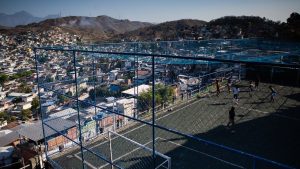100 Women: Football offers girls a shield in Brazil’s violent favelas
http://www.bbc.com/news/world-41473353
Within the artice, they talk about the extremely dangerous favelas within Brazil that are the battlegrounds between the police and drug gangs. within the article they provide a crazy statistic that states that a “Rio resident is hit by a stray bullet every 7 hours”, which shows exactly how often there is gun violence in the favelas of Rio, Brazil. because of all the violence, the youth is endlessly looking for ways to get away and stay safe throughout the day, and a way that a group of girls do this is by going to a pitch in the hills to play soccer. the pitch was built by a UK charity that gives under privileged youth an opportunity through sports. the charity wanted to make this area off limits to violence and talked to many of the residents, police and even gangs to help keep this area free of violence. although the residents and gangs have agreed to make this area off limits to all violence, the girls still have to cancel practices due to the frequent shootings that happen throughout the week. through all of this, the coach of the soccer team has helped over 300 children a year “reducing their risk of exploitation and abuse, developing their life skills, and improving their education, training, and employment opportunities.”.
The Latin American people in this article are portrayed as poor and violent but not by choice as they live in very poor situations and struggle to survive. The help that they receive to help protect the youth is extremely important as they are the future of that community and giving them the best opportunity to be the best that they can be will only help the community. Also how the gangs and police have both tried to agree to the restriction of violence in that area shows that even though they are committing crimes, their intention isn’t to hurt the children so it shows that they aren’t as completely savage as they are made out to be.
This article connects to the theme of identities of Latin America by showing how the people in Brazil were presented with a serious problem with violence and decided to make a change to help make the violence affect less of the youth in the area.


